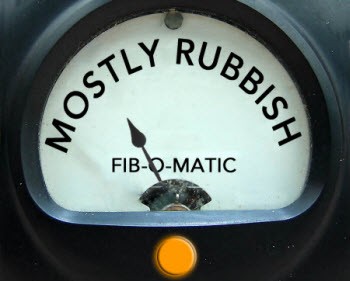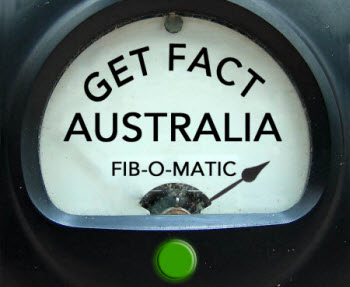Tony Abbott has had another shocker of a week with stuff-ups over the global positioning of the Indonesian president mixed with the fumes of the Barbara Ramjan saga, but fiscal types are still scratching their heads over his lower-profile claims on the state of the Australian economy.
In the latest instalment of Crikey‘s Get Fact Australia series, we analyse Abbott’s recent press conference rumination on what it would take to fit big Labor spending initiatives such as Gonski, Denticare or the National Disability Insurance Scheme into the federal budget. Take it away, Tone:
“Now, at the heart of what I offer to the Australian people is a return to economic growth. If we can get taxes down, if we can get unnecessary spending eliminated, if we can get productivity up, if we can get red and green tape down, we will have higher economic growth, we will attract the investment that our country needs to create jobs and boost prosperity and then, and only then, might we be able, some years down the track, to be able to afford the sort of think-big social programs that this Prime Minister is recklessly promising now.”
Let’s examine this one point at a time.
First, it seems strange that Abbott is positing a “return to economic growth” when, as the recently released national accounts showed, the Australian economy actually grew by 3.7% last financial year and is about to eclipse Spain as the world’s 12th largest economy.
Wayne Swan has been constantly crowing about 21 consecutive years of growth but that elation hasn’t been limited to his side of politics — Swan’s shadow Joe Hockey recently described our growth numbers as “extraordinary”.
One potential “in” for Abbott — which he didn’t mention — relates to Tim Colebatch’s analysis in Fairfax papers yesterday showing GDP per head had recovered much more slowly than in the aftermath of previous recessions. The total GDP increase was mostly due to population growth rather than productivity or workforce participation.
Next, Abbott reckons that boosting foreign investment and economic growth is contingent on four factors.
The first is the prescription to “get taxes down”. The main problem there is that taxes in Australia have been steadily falling as a proportion of economic output for several years — albeit mostly due to the drag in receipts from the global financial crisis. The 2012-13 budget papers showed the tax-to-GDP ratio is lower than most countries in the OECD, falling from 23.4% before the 2007 Ruddslide to 21.6% in 2010-11 under Rudd and Gillard (including forward estimates).
Further, tax receipts as a proportion of GDP since Whitlam show that taxes were lower under the Labor administrations of Hawke (22.3%), Keating (20.7%) and Rudd (21.45%) than under Abbott’s Liberal hero John Howard (22.3%).
What about the requirement to eliminate “unnecessary spending”? Given the lack of an Abbott economic plan, it’s currently hard to know what specific measures he considers “unnecessary”.
After May’s federal budget, finance spokesman Andrew Robb identified 49 costed policy areas it will take to the next election. The loss of revenue from the carbon tax will be covered by slashing its associated compensation schemes but it’s unlikely the full $46 billion in savings identified before the 2010 poll will be reprised. (The proposed $3.8 billion public service recruitment freeze could be still on the table). And it has one “Rolls-Royce” measure it will have to offset — a lavish 26-week parental leave scheme paid for by a hike in the company tax rate. Political partisans also point out that the Liberals have opposed elimination of some “unnecessary spending” such as the private health insurance rebate.
Further, the average government spending to GDP ratio under Rudd/Gillard (24.3%) is about the same as under Howard (24.2%), even factoring in the massive 2008-09 and 2009-10 fiscal stimulus.
Another prerequisite is to “get productivity up”. But what would that entail? Abbott might have room to move on the broad issue of multifactor productivity. A recent Economic Intelligence Unit study purported to show that Australia was ranked 50th out of 51 countries on total factor productivity growth (achieving a “score” of 10.3 out of 100). In a speech earlier this year senior treasury official David Gruen said that productivity growth since 2000 had lagged compared to previous decades.
But on the question of the more measurable labour productivity, Australia is doing OK. According to the ABS (via the Parliamentary Library), “labour productivity increased by 2.3% in the March quarter 2012, the largest quarterly increase for several years. The annual change in labour productivity for the 12 months to March 2012 was 5.3%.”
Gross Value Added per hour worked rose by 3.7% over the year to the June quarter — and average labour productivity growth during the Fair Work period was higher than under WorkChoices.
According to the Library, “over the last 20 (financial) years, labour productivity has grown at an annual average of 2.1%. Labour productivity grew in 2011-12 by 3.7% (its highest rate since 2002)”. This trend us supported elsewhere — a recent PriceWaterhouseCoopers productivity scorecard says labour productivity is at a “10-year high”.
What about the need to “get red and green tape down”? The newly promoted Arthur Sinodinos and Kelly O’Dwyer’s red tape taskforce is aiming to cut $1 billion a year, but the Libs also want to impose additional reporting requirements on foreign investment to placate the Nationals. Furthermore, the report is yet to be released — promised filing dates of “July 2012” and “August 2012” have flown by and the taskforce’s website remains empty.
Even if Abbott manages those tasks, what will be the result? “We will”, apparently, “have higher economic growth, we will attract the investment that our country needs to create jobs and boost prosperity.”
First, growth. As Get Fact has previously demonstrated, higher top marginal tax rates and “socialist” policies aren’t really an impediment to economic growth, either in Australia or in comparison with other countries. And socialist countries usually have (massaged) zero unemployment.
Now foreign investment. According to the Foreign Investment Review Board, foreign investment submitted for approval grew by 27% in 2011 — nearly back at pre-GFC levels, and investment generally is currently at a record high as a proportion of GDP. Abbott himself pointed out last month that there’d been a “surge” in foreign investment in agriculture, necessitating another look at the rules. In March, US mining consultancy Behre Dolbear ranked Australia the best destination for mining investment in the world for the third year running.
So Abbott would have to accelerate already promising trends. The result — more jobs — would need to be achieved against an unemployment rate that is much lower than comparable OECD countries (notwithstanding the large ranks of underemployed and disillusioned jobseekers).
At their root, most of Abbott’s assumptions seem to emanate from the widely discredited Laffer curve, which purports to show that reducing taxes on the rich would lead to freer firms, more profits and therefore more government revenue. Then — and only then — could cash be used for what he calls “big social programs”.
This was the theory underlying the Reagan tax cuts and the core of what George HW Bush referred to as “voodoo economics”. The problem was that after the 1981 Kemp-Roth cuts, US revenue fell well below where it was expected to be. The US deficit doubled to $155 billion and government debt tripled to more than $2 trillion.
If renewed turmoil in Europe leads to another global recession, such supply side theory would look even more dubious because, owing to well-established counter-cyclical tactics championed even by conservative economists, slashing spending and taxes during a downturn would actually ratchet down demand and stall growth and job creation.
Accordingly we rate Abbott’s claims about Australia’s shining path to economic salvation as “mostly rubbish”.










What a shock Abbott’s economic policy is a load of rubbish.
The one thing Abbott has going for him is that as all his goals are already being achieved as soon as he gets voted in the media cann immediately turn from their economic gloom and doom to isn’t everything wonderful now that Tony is here.
Now that the economic pressure is coming on the Abbott mob its interesting to see how thin their arguements really are.
The public will eventually wake up to this economic pigmy and all his urgers/mates in the MSM will also have to explain their involvement in the phoney Tony charade..
The problem is that Abbott, like his LNP mentor PM,has adopted the US tea party solution to everything; cut taxes, shaft the workers (by destroying organised labour-unions) and criticise any policy that works to the benefit of the body politic, but not necessarily the big end of town.
I find it rich that he is big on cutting red tape (read regulatory controls) yet has not learned the lessons of the GFC, never trust the capitalist system to look after the ordinary citizen. Law’s keep the B’s honest!
If you wish to see Abbott’s proposal’s in action look at Micharel Moore’s “Capitalism: a love story”, it covers what can happen here.
Of course it’s mostly rubbish, just like the Reaganomics and Bush policies in the US and look what happened over there.
He forgot “…. and if I had wings and a magic wand people would take me more seriously when I run off at the mouth like this …. Does my nose look big in these”?
I love the irony that most right wing policies that want to “boost growth”, “boost the economy” and “create jobs” actually work the other way and create things like the GFC…